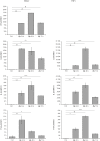IFNγ-dependent silencing of TFF1 during Helicobacter pylori infection
- PMID: 36514982
- PMCID: PMC9748780
- DOI: 10.1098/rsob.220278
IFNγ-dependent silencing of TFF1 during Helicobacter pylori infection
Abstract
Chronic Helicobacter pylori infection is the leading cause of intestinal-type adenocarcinoma, as prolonged Helicobacter colonization triggers chronic active gastritis, which may evolve into adenocarcinoma of the intestinal type. In this environment, cytokines play a significant role in determining the evolution of the infection. In combination with other factors (genetic, environmental and nutritional), the pro-inflammatory response may trigger pro-oncogenic mechanisms that lead to the silencing of tumour-suppressor genes, such as trefoil factor 1 (TFF1). The latter is known to play a protective role by maintaining the gastric mucosa integrity and retaining H. pylori in the mucus layer, preventing the progression of infection and, consequently, the development of gastric cancer (GC). Since TFF1 expression is reduced during chronic Helicobacter infection with a loss of gastric mucosa protection, we investigated the molecular pathways involved in this reduction. Specifically, we evaluated the effect of some pro-inflammatory cytokines on TFF1 regulation in GC and primary gastric cells by RT-qPCR and luciferase reporter assay analyses and the repressor role of the transcription factor C/EBPβ, overexpressed in gastric-intestinal cancer. Our results show that, among several cytokines, IFNγ stimulates C/EBPβ expression, which acts as a negative regulator of TFF1 by binding its promoter at three different sites.
Keywords: helicobacter; interferon-gamma; trefoil factor 1.
Conflict of interest statement
We declare we have no competing interests.
Figures







References
Publication types
MeSH terms
Substances
LinkOut - more resources
Full Text Sources
Medical
Molecular Biology Databases
Miscellaneous
